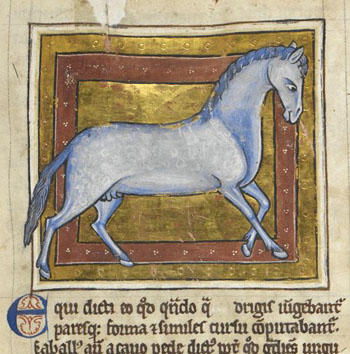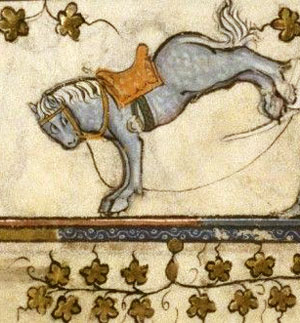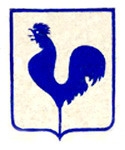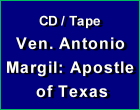Stories & Legends
 |
 |
 |
 |
 |
 |
 |
The Horse Lent to Pope John I
In the time of the Goths, Pope John I, the holy Bishop of Rome, undertook a very sensitive mission to the court of Constantinople to reconcile the Arians there with the Catholic Church.
In Corinth, he found himself in need of a saddle horse and made inquiries to obtain one. A nobleman who heard of his need offered the Pope a horse, on condition that it be sent back to him as soon as another suitable one could be found to replace it. This particular horse was his wife's favorites, on account of it being so gentle.

 The Bishop of Rome agreed to the conditions and continued on his way. And, as soon as the horse could be replaced, he sent it back to the nobleman and his wife.
The Bishop of Rome agreed to the conditions and continued on his way. And, as soon as the horse could be replaced, he sent it back to the nobleman and his wife.
But when the noble lady again wished to mount it, she found herself unable to do so. The horse would refuse to let her mount. It snorted and balked continually, as if to indicate openly that it could not seat a woman after having carried the Vicar of Christ.
Her husband, realizing this to be a sign of respect that a mere animal paid to the Papacy, sent the horse back to Pope John with the request that he keep it as his own, for in carrying him, the horse had dedicated itself to his personal service.
Our forefathers also tell us that when Pope John came to Constantinople, he restored sight to a blind man in the presence of an immense throng that had gathered at the gate which is called The Golden Gate. As the Pope placed his hand on the eyes of the man who asked to be cured, all darkness was lifted from them. Thus God sought to soften the hearts of the Emperor and people to favor his mission.
And indeed this happened. Greeting him, the Emperor prostrated himself before Pope John out of a sentiment of veneration. Having arranged matters with the Emperor, Pope John proceeded to consecrate all the Churches of the Arians that he could find so that they might be used for Catholic service.
This success did not please King Theodoric, who was a heretic and had wanted Pope John to persuade the Emperor Justin to modify the stern decree he had enacted against the Arians . Therefore, shortly after the Pope's return, the King arranged for him to come to Ravenna, where he was seized and thrown into a filthy prison, where he died shortly afterwards from ill treatment. It was the year 683, and he had reigned two years, nine months and 14 days.
The Church rewarded Pope John with the title of martyr, won by this holy Pope for battling for the Church's liberty against a Christian King.
Further on in his Dialogues, Pope St. Gregory the Great relates how Divine Justice dealt with the heretic King Theodoric. A hermit of the Lipari Island described as having seen with his own eyes Theodoric, on the day of his death, carried in bonds between Pope John and Pope Symmachus (whom the King had also ordered to be killed). The heretic King, justly damned, was cast into the fiery volcano of Lipari.


In Corinth, he found himself in need of a saddle horse and made inquiries to obtain one. A nobleman who heard of his need offered the Pope a horse, on condition that it be sent back to him as soon as another suitable one could be found to replace it. This particular horse was his wife's favorites, on account of it being so gentle.

The horse lent to Pope John I afterwards refused to allow anyone to mount it

But when the noble lady again wished to mount it, she found herself unable to do so. The horse would refuse to let her mount. It snorted and balked continually, as if to indicate openly that it could not seat a woman after having carried the Vicar of Christ.
Her husband, realizing this to be a sign of respect that a mere animal paid to the Papacy, sent the horse back to Pope John with the request that he keep it as his own, for in carrying him, the horse had dedicated itself to his personal service.
Our forefathers also tell us that when Pope John came to Constantinople, he restored sight to a blind man in the presence of an immense throng that had gathered at the gate which is called The Golden Gate. As the Pope placed his hand on the eyes of the man who asked to be cured, all darkness was lifted from them. Thus God sought to soften the hearts of the Emperor and people to favor his mission.
And indeed this happened. Greeting him, the Emperor prostrated himself before Pope John out of a sentiment of veneration. Having arranged matters with the Emperor, Pope John proceeded to consecrate all the Churches of the Arians that he could find so that they might be used for Catholic service.
This success did not please King Theodoric, who was a heretic and had wanted Pope John to persuade the Emperor Justin to modify the stern decree he had enacted against the Arians . Therefore, shortly after the Pope's return, the King arranged for him to come to Ravenna, where he was seized and thrown into a filthy prison, where he died shortly afterwards from ill treatment. It was the year 683, and he had reigned two years, nine months and 14 days.
The Church rewarded Pope John with the title of martyr, won by this holy Pope for battling for the Church's liberty against a Christian King.
Further on in his Dialogues, Pope St. Gregory the Great relates how Divine Justice dealt with the heretic King Theodoric. A hermit of the Lipari Island described as having seen with his own eyes Theodoric, on the day of his death, carried in bonds between Pope John and Pope Symmachus (whom the King had also ordered to be killed). The heretic King, justly damned, was cast into the fiery volcano of Lipari.

The fiery volcano of Lipari Island
Adapted from St. Gregory the Great, Dialogues, trans. by Odo John Zimmerman,
pp. vol 39, The Catholic University of America Press, 1959, pp. 115-116
Posted June 13, 2020
pp. vol 39, The Catholic University of America Press, 1959, pp. 115-116
Posted June 13, 2020



